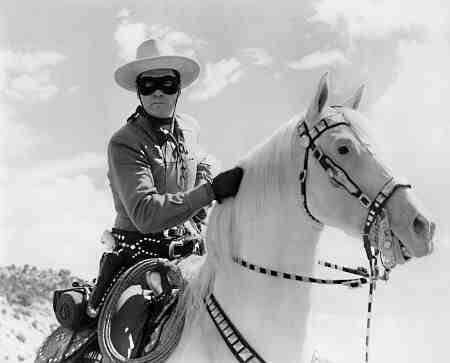The Lone Ranger
THE LONE RANGER
By TOM SOTER
from ENTERTAINMENT WEEKLY MAGAZINE
 Hi-yo, Silver: Clayton Moore was that masked man.
Hi-yo, Silver: Clayton Moore was that masked man.
To the strains of Rossini's "William Tell Overture," over images of a masked man riding a majestic white stallion, a narrator breathlessly speaks the words that thrilled a generation: "A fiery horse with the speed of light, a cloud of dust, and a hearty 'Hi-Yo, Silver! The Lone Ranger rides again!"
The Lone Ranger was a landmark show in two mediums: on radio from 1933-1956, it was so successful that it became the basis for a radio network, while on television from 1949-57, it marked the first bonafide hit for the fledgling American Broadcasting System. No wonder. The program's appeal is as timeless as that of Robin Hood and Zorro, with whom the Ranger had much in common.
The series, which followed the adventures of a former Texas Ranger who wore a mask and battled evil, may have been kid stuff but it was loaded with adult messages: the Ranger was friends with Tonto, a Native American, before it was fashionable; he always shot to wound, never to kill; and he spoke with perfect diction. And, like the heroes of The X-Files, the masked man believed in truth and justice, helping the underdog without asking for anything in return.
The show had its appealingly operatic touches: a silver bullet was the hero's calling card while his mask was meant to strike fear into the hearts of his foes. But the Ranger was modest, too, riding off as soon as the job was done, just as those he had helped would invariably ask, "Who was that masked man?" Who indeed? A true American folk hero.
Sidebar
Years on air: 1949-57 (premiered on radio in January 1933).
Top Nielsen Rating: No. 7 (1950-51). Emmys Won: 0
Ranger for Life: For most of its run, the Ranger was perfectly personified by Clayton Moore, a B-movie actor who found his calling as the masked man. He starred in over 100 episodes, two feature films, and then made a career of appearing at charity events as the character. He was involved in a lawsuit in 1981 when the producers of a new Lone Ranger film tried to get him to stop wearing the mask. He recently published an autobiography, I Was That Masked Man.
Series Firsts: The series was the first to have a Native American play a Native American (Jay Silverheels as Tonto). In an era of live television, the show was one of the first to be filmed.
Ranger Secrets: Tonto's pet phrase for the Ranger, "Kemo-Sabe," was supposedly Indian dialect for "faithful friend." It was actually the name of a summer camp.
Where to Find Him: The Lone Ranger's adventures are now rerun on TVLand.
Classic Touch: The show's theme, the "William Tell Overture," was chosen because the producers of the radio show felt that it was suggestive of a horse galloping.
All in the Family: The Green Hornet radio series was a spinoff of The Lone Ranger. Set in the 1930s, the series featured a masked character and also used a classical tune as its theme ("Flight of the Bumblebee"). The Hornet was a great-nephew of the Ranger.